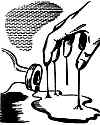|
Various groups
eagerly tried to find how it was done but when they
failed they turned to substitutes. The Egyptians experimented with many
materials even to spinning thread from the spider's web and this was
tried again as late as 1750 when a Frenchman organized the Spider Silk
Works and turned out gloves and stockings. But real silk culture,
however, in France, began about the time Columbus discovered America
when they successfully duplicated the Chinese product.
Things, however, did not always go well with the French. In 1860 a mysterious parasite threatened to ruin the industry which was centered at Lyon. In desperation the growers called on the great French scientist, Louis Pasteur, to help them. Pasteur had a very able research assistant, de Chardonnet who, as a result of his work on this project, gained a first hand knowledge of silk which was to prove of great value to him later.  Chardonnet was also extremely interested in photography and, one
day, when coating some photographic plates, he accidently spilled a
bottle of collodion. He left the sticky mess but came back later when
it was partially dry and tried to clean it up. In doing this, he pulled
out some long filaments of the material which closely resembled silk.
Chardonnet knew that a silk substitute would have a great value, so
starting with collodion, he began a long series of experiments until he
at last developed an artificial silk fiber from which he produced
fabrics. These materials were exhibited at the Paris Exposition in 1889.
Chardonnet was also extremely interested in photography and, one
day, when coating some photographic plates, he accidently spilled a
bottle of collodion. He left the sticky mess but came back later when
it was partially dry and tried to clean it up. In doing this, he pulled
out some long filaments of the material which closely resembled silk.
Chardonnet knew that a silk substitute would have a great value, so
starting with collodion, he began a long series of experiments until he
at last developed an artificial silk fiber from which he produced
fabrics. These materials were exhibited at the Paris Exposition in 1889. |








